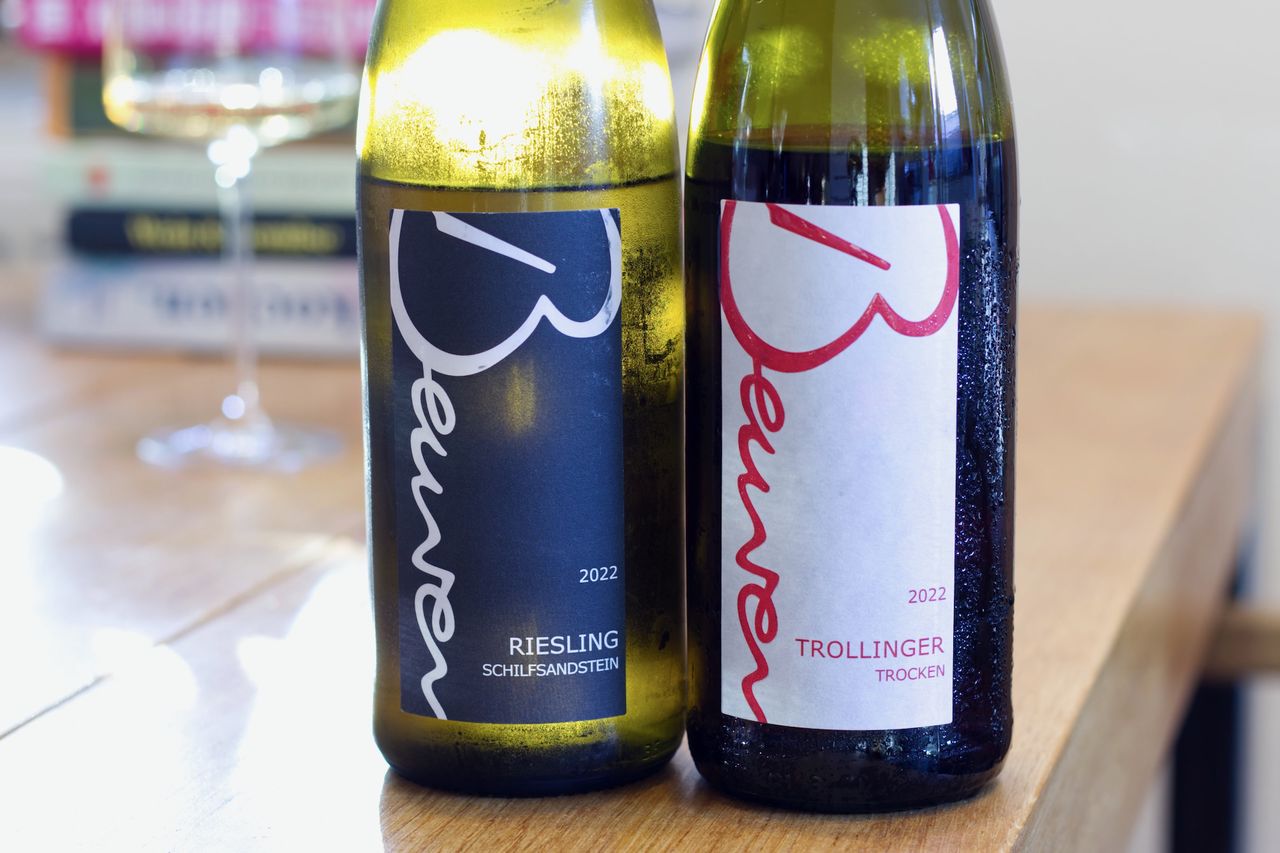Two Bottles Beurer
We are drinking a Trollinger and a Riesling Schilfsandstein from Weingut Beurer in the Remstal, both from the 2022 vintage.

When it’s dark again at five in front of the window and the tear-off calendar gets thinner, there aren’t many days left in the year. Time to process a bit of what we’ve encountered throughout the year and mentally noted on the quick follow-up list. These will mainly be wines from Rheinhessen, but I want to start with a bit of home. In the middle of summer, the second edition of the Stuttgarter Landweintreff invited us to the old state parliament of the state capital. Perhaps the only wine fair in the world that I would recommend solely for the merchandise. Because a Swabian Vierteleschlotzer who values himself needs a shopping bag with a happily green stemmed glass. Makes life more livable, believe me. The selection of wineries on site is, of course, at least on par. Now that I think about it, it’s somehow funny that I’m using the only VDP estate (I believe at least it was the only one) from the lineup between underdogs and hype producers to mention this fair. The more experienced online storyteller would probably have approached this differently. However, anyone who gets to see the bottles in the picture from behind will be able to confirm that Landwein and VDP don’t have to contradict each other. A fact that should have reached everyone at the latest with the inclusion of Odinstal in the Palatinate association. The Trollinger here is, also according to the back label, a special bottling for the Weinhalle, but I promise it tasted exactly the same at the fair. At least in my memory. The vines for the wine stand in the Remstal, the grapes are openly fermented on the mash and then aged in used wood for ten months before being bottled with just over 10% alcohol. The Schilfsandstein is a repeat offender here on the blog. The vines grow on reed sandstone, as the name suggests. The Riesling is fermented and aged in stainless steel.
After unscrewing, the Trollinger first happily stinks away. This either needs a proper portion of air or you simply drink it directly with food, as we’re doing today. Contrary to more sophisticated storytelling, I’ve planned ahead on the food pairing front, and the inclined reader already knows what that means. Lentils, namely. With Saiten and Spätzle. And as expected, it’s nothing less than great together. I’m going out on a limb and claiming that the wine was made exactly for this kind of thing. As a Vesper (dinner) wine, whether cold or warm, everyone can decide for themselves. Both for the Vesper and for the Trollinger. It also tastes good chilled.
After the meal, there’s marzipan in the aroma, red berries, and some herbs. There’s pull behind it, lots of freshness, and a slightly impetuous tannin. Not super complex, not at all boring. As I said, eat something with it, preferably lentils. It makes the food better and the wine.
The stinker has disappeared on the second evening. And indeed, even solo, this is really fun. German Poulsard is often thrown into the room when such a Trollinger is poured. And that’s not entirely wrong. Those who can overcome their prejudices can really enjoy this. The freshness, the cherry fruit, the acidity pull, and the slightly rustic but not strenuous tannin. It’s got something. The better half murmurs hibiscus-apple fruit tea, and I’m on board with that too. I like it very much.
The Riesling starts really juicy. Even when smelling. There’s a lot of mirabelle, apple, and herbs. Radiant and clear, and exactly how the wine smells is how it tastes. I like the structure, it’s somehow special. Over the years, we’ve had a Schilfsandstein in the glass again and again and, not that I would claim to recognize the wine blind, never, but when I have it in my mouth, I think every time, yes, this is Beurer Schilfsandstein. This slightly barren minerality in the middle of the tongue, the length, the way it feels on the tongue, it’s just somehow special. And it becomes really round through the fruit that replaces the barrenness on the finish.
Unlike the Trollinger, the Riesling hardly changes overnight. The individual elements may merge a touch more at most. The clarity and radiance don’t need any further development, it’s simply beautiful as it is and will certainly remain so for several years. A reason to dip one’s toes into Swabian Riesling water. The approximately 15 euros are well-invested discovery budget, and if you’re already opening a shipping carton, there’s still the Trollinger. And for those who are really hooked on the best wine region of the republic, they can then drink Berge . Or go on a Landwein discovery tour. It won’t remain the only winery from the fair here. Promise.